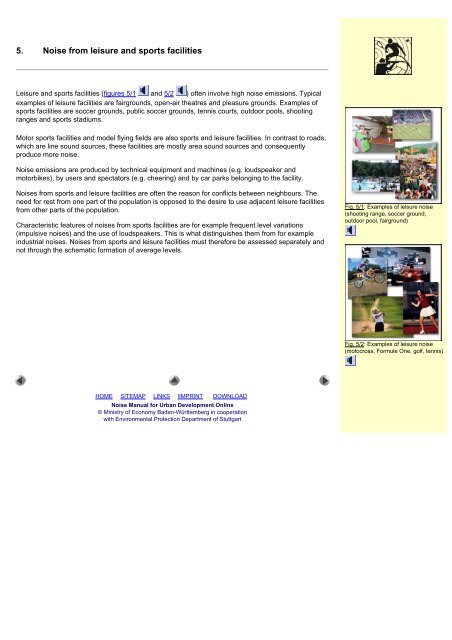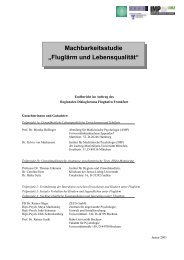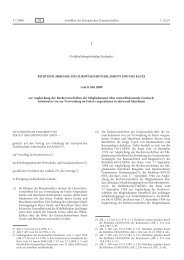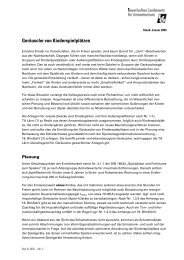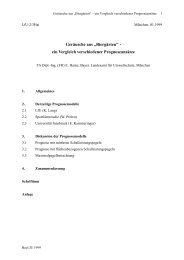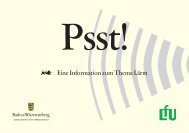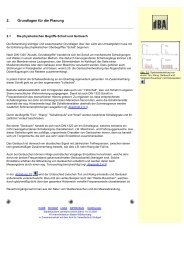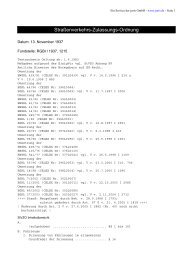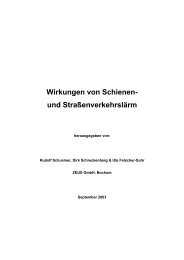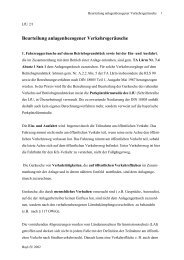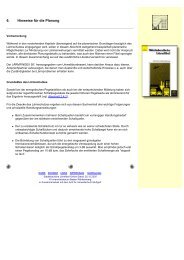Kapitel 5
Kapitel 5
Kapitel 5
Create successful ePaper yourself
Turn your PDF publications into a flip-book with our unique Google optimized e-Paper software.
5. Noise from leisure and sports facilities<br />
Leisure and sports facilities (figures 5/1 and 5/2 ) often involve high noise emissions. Typical<br />
examples of leisure facilities are fairgrounds, open-air theatres and pleasure grounds. Examples of<br />
sports facilities are soccer grounds, public soccer grounds, tennis courts, outdoor pools, shooting<br />
ranges and sports stadiums.<br />
Motor sports facilities and model flying fields are also sports and leisure facilities. In contrast to roads,<br />
which are line sound sources, these facilities are mostly area sound sources and consequently<br />
produce more noise.<br />
Noise emissions are produced by technical equipment and machines (e.g. loudspeaker and<br />
motorbikes), by users and spectators (e.g. cheering) and by car parks belonging to the facility.<br />
Noises from sports and leisure facilities are often the reason for conflicts between neighbours. The<br />
need for rest from one part of the population is opposed to the desire to use adjacent leisure facilities<br />
from other parts of the population.<br />
Characteristic features of noises from sports facilities are for example frequent level variations<br />
(impulsive noises) and the use of loudspeakers. This is what distinguishes them from for example<br />
industrial noises. Noises from sports and leisure facilities must therefore be assessed separately and<br />
not through the schematic formation of average levels.<br />
Fig. 5/1: Examples of leisure noise<br />
(shooting range, soccer ground,<br />
outdoor pool, fairground)<br />
Fig. 5/2: Examples of leisure noise<br />
(motocross, Formule One, golf, tennis)<br />
.<br />
HOME SITEMAP LINKS IIMPRINT DOWNLOAD<br />
Noise Manual for Urban Development Online<br />
© Ministry of Economy Baden-Württemberg in cooperation<br />
with Environmental Protection Department of Stuttgart
5. Noise from leisure and sports facilities<br />
5.1 Legal foundations<br />
The law branches that are affected by noise from leisure and sports facilities are basically pollution<br />
control rights, building law and civil law.<br />
For aspects in the context of urban land-use planning we would like to refer to § 50 of the Federal<br />
Immission Control Act, which regulates the allocation of areas earmarked for different types of use in<br />
the context of regional planning projects (see section 2.3.1). Regulations pursuant to the Federal<br />
Land Utilisation Ordinance (§§ 2 to 11) shall be considered within building areas: Sports facilities in<br />
purely residential areas are only permitted if they are useful for the residents of this area. Sports<br />
facilities are generally permitted in general residential areas, special residential areas, mixed areas,<br />
village areas and core areas. They are exceptionally permitted in small housing estates, commercial<br />
areas and industrial areas.<br />
What is especially affected in civil law is the neighbouring rights within §§ 906 and 1004 of the<br />
German Civil Code.<br />
The relevant legal foundation for pollution control aspects is the Federal Immission Control Act. In the<br />
case of leisure facilities subject to licensing pursuant to § 4 of the Federal Immission Control Act or to<br />
the 4th Federal Immission Control Ordinance, the authorities must check whether and to what extent<br />
specific conditions and obligations for the protection from harmful noises shall be tied to the granting<br />
of a license (§ 12 of the Federal Immission Control Act). If necessary, the license can also be<br />
withheld. Subsequent orders in the case of harmful environmental impacts from noises can be issued<br />
pursuant to § 17 of the Federal Immission Control Act.<br />
All installations where motor sport is practised and exercised on five or more days per year count<br />
among installations subject to licensing, with the exception of model sports facilities. Shooting ranges<br />
for small arms are also included.<br />
Other regularly or permanently operated facilities, like sports fields, sports halls, bobsleigh runs etc.,<br />
are installations not subject to licensing within the meaning of the Federal Immission Control Act. The<br />
obligations for operators of installations not subject to licensing are regulated in § 22 of the Federal<br />
Immission Control Act, saying that "installations not subject to licensing shall be constructed and<br />
operated in such a way that any harmful effects on the environment which are avoidable with the use<br />
of the best available techniques are prevented" or kept to a minimum. § 23 authorizes the Federal<br />
Government "to require by ordinance ... that the construction, nature and operation of installations not<br />
subject to licensing meet specific requirements". The Ordinance on the Prevention of Noise from<br />
Sports Facilities (18th Federal Immission Control Ordinance) is grounded on this legal basis.<br />
§§ 24 and 25 of the Federal Immission Control Act regulate orders on a case-to-case basis (technical<br />
protective measures and time limits) and the prohibition of the operation of installations not subject to<br />
licensing.<br />
.<br />
HOME SITEMAP LINKS IIMPRINT DOWNLOAD<br />
Noise Manual for Urban Development Online<br />
© Ministry of Economy Baden-Württemberg in cooperation<br />
with Environmental Protection Department of Stuttgart
5. Noise from leisure and sports facilities<br />
5.2 Calculation and assessment foundations<br />
The 18th Federal Immission Control Ordinance is applied to sports facilities not subject to licensing.<br />
VDI 3770 gives characteristic noise emission values for sports and leisure facilities.<br />
The German government has adopted the 18th Ordinance on the Implementation of the Federal<br />
Immission Control Act (Ordinance on the Prevention of Noise from Sports Facilities) and published it<br />
in the Federal Law Gazette on 18 July 1991. This ordinance is based on the former draft of VDI<br />
guideline 3724, which has been withdrawn.<br />
.<br />
HOME SITEMAP LINKS IIMPRINT DOWNLOAD<br />
Noise Manual for Urban Development Online<br />
© Ministry of Economy Baden-Württemberg in cooperation<br />
with Environmental Protection Department of Stuttgart
5. Noise from leisure and sports facilities<br />
5.2.1 "Sports and the environment" expert opinion by the Environment<br />
Minister of the Land of Lower Saxony<br />
This expert opinion is to form a basis for experts and planners for the assessment of noise from<br />
sports facilities. It was developed by TÜV Norddeutschland (an association for technical inspection,<br />
section Northern Germany) by order of the Environment Ministry of Lower Saxony. Its aim is to<br />
determine the sound emissions depending on the type and size of a sports facility and to give<br />
assessment and noise protection indications.<br />
What is measured is the noise from tennis courts, soccer grounds, school sports facilities and public<br />
soccer grounds as well as outdoor pools, model flying fields, motor sports facilities and ice stadiums.<br />
The expert opinion is based on numerous sound level measurements in the vicinity of sports and<br />
leisure facilities. It contains information on the measurement and assessment procedure as well as<br />
detailed results of sound level measurements at sports and leisure facilities. Some of the results are<br />
given below:<br />
An impulse-weighted average sound level from 54 to 56 dB(A) is determined in a distance of 30 m<br />
from the ball fence of tennis courts with 3 to 8 courts. The measurements at smaller tennis courts<br />
reach up to 53 dB(A). The sound power level for each court can be assumed at 83 dB(A). An impulse<br />
addition of 10 dB(A) is necessary. For noise prognoses the expert opinion recommends to calculate<br />
the propagation according to VDI guideline 2714 (Outdoor sound propagation) taking the sound<br />
power level as emission value.<br />
The average sound levels for soccer games range from 49 to 56 dB(A) in a distance of 50 m from the<br />
boundary of the playing field (less than 300 spectators). The maximum level for cries of goal reaches<br />
80 dB(A) (200 spectators), the referee's whistle 75 dB(A) and the shouts and cheers of players and<br />
spectators between 60 and 70 dB(A). The expert opinion recommends a sound power level of 100 dB<br />
(A) for the noise prognosis of soccer games with one soccer field. The conspicuousness of the<br />
sounds requires an addition of 6 dB(A). Sound immissions shall be calculated according to VDI 2714.<br />
The noises from spectators must be considered separately.<br />
Sound power levels between 88 and 95 dB(A) can be expected for each public soccer field. The<br />
conspicuousness of the sounds require an addition of 6 dB(A).<br />
The sound power level for outdoor pools is determined at about 108 dB(A) for 600 to 1,000 bathers.<br />
.<br />
HOME SITEMAP LINKS IIMPRINT DOWNLOAD<br />
Noise Manual for Urban Development Online<br />
© Ministry of Economy Baden-Württemberg in cooperation<br />
with Environmental Protection Department of Stuttgart
5. Noise from leisure and sports facilities<br />
5.2.2 Indications for the assessment of leisure noise<br />
Indications for the assessment of noise from leisure facilities were assembled by the Länder<br />
Committee for immission control in Annex B (Ordinance on Noise from Leisure Facilities) of its model<br />
administrative regulation on the determination, assessment and reduction of sound immissions<br />
(1995).<br />
The indications refer to the protection of the resident population in the built-up proximity of leisure<br />
facilities. They help to assess harmful effects on the environment within the meaning of the Federal<br />
Immission Control Act (see section 2.3.1). Harmful effects represent a considerable annoyance for<br />
the neighbourhood or the general public. The relevance of the sounds depends on their intensity as<br />
well as on the type of use of the territory, the type of sound, the impact period and the attitude of the<br />
affected people towards the noise source.<br />
§ 22 of the Federal Immission Control Act regulates that harmful effects on the environment must be<br />
prevented or kept to a minimum in the case of existing leisure facilities not subject to licensing. A<br />
prohibition of the operation pursuant to § 25 of the Federal Immission Control Act shall only be<br />
considered if "the life or health of human beings ... or valuable material assets" are threatened. The<br />
indications determine the limit of reasonableness in the case of permanent sounds at 60 dB(A) during<br />
the day and 45 dB(A) during the night.<br />
Conflict situations, like the proximity of residential areas and leisure facilities, which are incompatible<br />
with the needs of the residents, require mutual consideration. Residents must perhaps accept more<br />
noise than elsewhere if all proportional noise abatement measures have been taken at the leisure<br />
facilities. The sound levels which must be tolerated shall preferably not exceed the immission values<br />
of the type of area with the next lower protection claim.<br />
Single sounds from human behaviour can also be assessed pursuant to the law governing<br />
administrative offences. What is relevant here is the question of whether third parties disapprove of<br />
the sound (e.g. in the case of parties or the playing of an instrument or if there is no objective social<br />
reason for the sounds). In the case of planned installations, possible disturbances from car parks,<br />
loudspeakers, cheers of spectators etc. must be considered.<br />
The regulation provides indications on the determination and assessment of the rating level of noises<br />
from leisure facilities and lists the most important leisure facilities with deliberations on assessment<br />
standards and remedial measures in its annex.<br />
.<br />
HOME SITEMAP LINKS IIMPRINT DOWNLOAD<br />
Noise Manual for Urban Development Online<br />
© Ministry of Economy Baden-Württemberg in cooperation<br />
with Environmental Protection Department of Stuttgart
5. Noise from leisure and sports facilities<br />
5.2.3 VDI 3770 Characteristic noise emission values for technical sound<br />
sources at sports and leisure facilities<br />
VDI guideline 3770 contains characteristic noise emission values for the following sound sources in<br />
the context of sports and leisure facilities:<br />
●<br />
Human beings - communication noises<br />
●<br />
Soccer<br />
●<br />
Hockey<br />
●<br />
American Football<br />
●<br />
Tennis<br />
●<br />
Ice hockey<br />
●<br />
Public ice skating<br />
●<br />
Ice stock sport<br />
●<br />
Ice stock sport in the summertime<br />
●<br />
Skateboard facilities<br />
●<br />
Open-air swimming pools and fun facilities<br />
●<br />
Athletic events<br />
●<br />
Public soccer grounds<br />
●<br />
Beer gardens and other open-air<br />
communication areas<br />
●<br />
Motor sports facilities<br />
.<br />
HOME SITEMAP LINKS IIMPRINT DOWNLOAD<br />
Noise Manual for Urban Development Online<br />
© Ministry of Economy Baden-Württemberg in cooperation<br />
with Environmental Protection Department of Stuttgart
5. Noise from leisure and sports facilities<br />
5.2.4 Ordinance on the Prevention of Noise from Sports Facilities (18th<br />
Federal Immission Control Ordinance)<br />
The Ordinance on the Prevention of Noise from Sports Facilities (18th Federal Immission Control<br />
Ordinance from 1991) (available in German) is applicable to the construction, nature and operation of<br />
sports facilities unless they are subject to licensing pursuant to § 4 of the Federal Immission Control<br />
Act. Sports facilities are defined as stationary facilities for exercising operated for this purpose (this<br />
does not include e.g. children's playgrounds or recreational sports activities on paths and in open<br />
land). Sports facilities also cover nearby facilities with a close spatial and operation relation, like<br />
parking lots or restaurants.<br />
The 18th Federal Immission Control Ordinance provides immission guide values for the construction<br />
and operation of sports facilities which shall not be exceeded (table 5/1).<br />
Single short-time peak values may not exceed the immission guide values by more than 30 dB(A)<br />
during the day and more than 20 dB(A) at night.<br />
Furthermore, immission values of 35 dB(A) at daytime and 25 dB(A) at nighttime are designated for<br />
habitable rooms in dwellings which are connected with sports facilities (e.g. within housing<br />
complexes). Single peak values may not exceed the last-mentioned values by more than 10 dB(A).<br />
The determined periods are as follows: Daytime covers the period between 6 am and 10 pm on<br />
weekdays and between 7 am and 10 pm on Sundays and holidays. Nighttime is everything else. Rest<br />
periods are from 6 am to 8 am and from 8 pm to 10 pm on weekdays. On Sundays and holidays, the<br />
rest period is from 7 am to 9 am and from 8 pm to 10 pm plus the two hours from 1 pm to 3 pm. This<br />
noon rest must only be considered if sports facilities are used more than 4 hours on Sundays and<br />
holidays between 9 am and 8 pm.<br />
Uses at daytime at nighttime<br />
outside the rest periods<br />
within the rest<br />
periods<br />
Commercial areas 65 60 50<br />
Core areas, village areas, mixed<br />
areas<br />
60 55 45<br />
General residential areas, small<br />
housing estates<br />
55 50 40<br />
Purely residential areas 50 45 35<br />
Spa areas, rest homes, hospitals 45 45 35<br />
Fig. 5/3: Examples of sports facilities<br />
Table 5/1: Immission guide values in dB(A) pursuant to the 18th Federal Immission Control<br />
Ordinance<br />
Exceptions to the regulations and orders can be made if the noise from sports facilities is superposed<br />
by permanent and predominant extraneous sounds. The competent authority can also fix hours of<br />
operation (except for open-air swimming pools and school sport facilities). Hours of operation shall<br />
not be fixed if the immission values are very rarely exceeded. Exceedances are rare if they occur on<br />
a maximum of 18 calendar days per year.<br />
Immission guide values in the context of rare events may be exceeded by at most 10 dB(A), provided<br />
that a level of 70 dB(A) is by no means exceeded outside the rest period at daytime, that of 65 dB(A)<br />
within the rest period and that of 55 dB(A) at night. Single short-time peak values may not exceed the<br />
immission guide values by more than 20 dB(A) during the day and more than 10 dB(A) at night.<br />
An annex to the ordinance contains the determination and assessment procedure. What must be<br />
considered besides the noise from the sports facility and its equipment is, if necessary, traffic noises<br />
from public circulation areas outside the facility provided that the traffic volume can be assigned to<br />
the facility.<br />
Rating level and maximum level of single peak noises are determined on the basis of intensity, length
and frequency of the noises. The assessment is made for the different periods (outside or within rest<br />
periods), during the night for the most unfavourable hour. If different emissions occur within an<br />
assessment period, the distribution of the occurring noises must be considered. The impulsive<br />
characteristics of noises (e.g. the bouncing of balls) are considered with an addition to the rating<br />
level. Sounds with discrete components and information incorporation (e.g. loudspeaker<br />
announcements) result in an addition of 3 dB(A) or 6 dB(A) to the rating level due to their increased<br />
nuisance effect.<br />
Rating levels can be both calculated (with reference to VDI guidelines 2714 and 2720-1) and<br />
measured.<br />
If the rating level is measured, it must be reduced by 3 dB(A) when compared with the immission<br />
guide values. This accounts for measurement instabilities in favour of the operator of an installation.<br />
If necessary, exterior living areas like terraces, balconies and home gardens shall also be considered<br />
in the assessment.<br />
.<br />
HOME SITEMAP LINKS IIMPRINT DOWNLOAD<br />
Noise Manual for Urban Development Online<br />
© Ministry of Economy Baden-Württemberg in cooperation<br />
with Environmental Protection Department of Stuttgart
Fig. 5/3: Examples of sports facilities<br />
.


